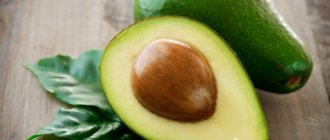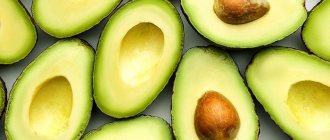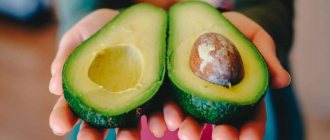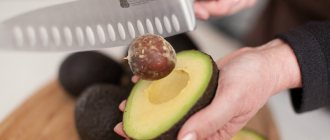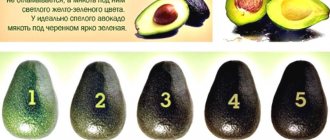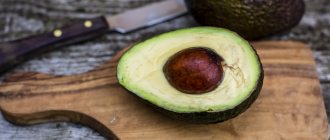Cashback → Lifehacks → How to choose a ripe avocado?
Although avocado does not grow in our latitudes, it has firmly taken its position as one of our favorite fruits. This popularity is justified by its versatility, light nutty flavor and creamy pulp, which is good both as an independent dish and in combination with other ingredients.
However, many are faced with the difficulty of choosing a fruit. After reading the article, you will learn how to choose an avocado so that it is ripe and what to do if you still come across an unripe fruit.
Meet the avocado
Do you think avocado is a fruit or a vegetable? The fruit grows on an evergreen tree of the laurel family. From a botanical point of view, it is considered a single-seeded berry, although the taste is not sweet. Externally, the fruit looks like a pear with a rough peel and even has an alternative name in Russian - “alligator pear.”
How to determine the ripeness of an avocado
The unripe fruit is tart and sour. It is impossible to eat it raw, and the taste of other dishes will not change for the better. How can you tell if a fruit is ripe right in the supermarket? Pay attention to two parameters: color and hardness.
Table 1. How to determine the ripeness of an avocado by appearance
| Peel color | Ripeness degree | When can you use it? |
| Bright green (emerald) | Immature | In 5-6 days |
| Swamp green (khaki) | Almost ripe | In 2-3 days |
| Dark green with brown tint | Mature | Immediately after purchase |
| Very dark, no green tint | Overripe | Not usable |
If you are in doubt about the color, it is better to buy an unripe fruit. Wrap in a plastic bag and leave to ripen on the windowsill.
Do not confuse overripe fruit with the California Haas variety. The latter has a natural black color. It is considered one of the most delicious types of avocado. Its pulp is very oily and sweet.
And now about how hard a fresh fruit should be. Gently squeeze it in your palm. Do not touch the peel with your nails - it is quite fragile.
- If the fruit is hard, like a ripe apple, it means it is not yet ripe.
- Moderate firmness and elasticity indicate that the avocado is good and suitable for consumption.
- Softness, remaining dents after pressing, dark spots on the skin are signs that the exotic berry has already begun to rot. You should not choose soft avocados when purchasing.
We recommend: Freezing peaches for the winter: 6 best storage methods
So, you bought a ripe fruit. Now we need to figure out how to peel an avocado before eating.
Main signs of ripe fruit
In addition to the rules discussed above for determining the ripeness of an avocado, in order to choose a quality product, you need to take into account standard factors that apply to most fruit crops. Its surface must be clean, without any damage, defects or signs of parasites. Important signs of a good ripe avocado include:
- dark shade of the peel, which immediately differs from unripe fruits;
- uniform skin color without light areas;
- elastic surface without dents;
- the stalk is bright green;
- pleasant smell reminiscent of nut butter.
You can choose an avocado without focusing on its shape, since it may differ for ripe fruits of different varieties. Florida and Pinkerton are shaped like a small elongated pear, while Californian has a more rounded outline. The fruits of these species practically do not differ in taste. You can feel the difference only in ripe and overripe or unripe fruits.
Very often, preference when choosing is given to larger fruits, but it should be noted that size is not an indicator of ripeness. The bone in them is also very large, which affects the amount of tasty pulp. Its shape in different varieties can be round or oblong.
Cleaning process
You can do a final ripeness check at home. Cut the cutting from the top, evaluate the color and smell. The pulp of the ripe berry is yellow-green and smells like oil. An unripe avocado fruit is pale yellow inside. Externally, the pulp is like a pear and has almost no odor.
Peeling an avocado is easy:
- Wash the fruit under running water and wipe dry with a towel.
- Use a sharp knife to make a longitudinal cut in a circle. Don't touch the bone.
- Hold the avocado in your palms and hook your thumbs around the top.
- With a little effort, divide the fruit into two halves.
- Remove the bone by picking it up with a knife.
- Using a teaspoon, remove the pulp from the skin.
Would you like to buy an avocado with a small pit at the store to get more valuable pulp after peeling? Choose Fuetre, Hass or Pinkerton varieties.
Like a ripe apple, a cut avocado immediately begins to darken and oxidize. To stop this process, sprinkle the pulp with lemon juice.
The shelf life of the fruit in the refrigerator is 2-3 days. I wonder how they eat it?
Fruit storage rules
Knowing how to choose the right ripe fruit, it will not hurt to learn how to store it. The storage conditions for ripe and unripe avocados are different.
Refrigerator conditions are best for storing ripe fruits. They are placed in a compartment for vegetables and fruits. It is convenient to keep them in the refrigerator in special food containers or zip bags. Under such conditions, the product can be stored for up to 5 days. If, for example, you saw beautiful avocados in the store a week before the New Year, you can safely buy them. They will keep in the refrigerator until the holiday without any problems.
The refrigerator is not suitable for storing unripe fruits. At low temperatures they will not be able to ripen, but will only deteriorate. For unripe fruits, room temperature is needed.
Important! Cut fruits are stored in the refrigerator only in closed containers. The pulp strongly absorbs foreign odors.
If the fruit has already been cut, its storage conditions are slightly different. The pulp tends to darken, like an apple. To prevent it from turning black, the cut should be greased with vegetable oil or lemon juice. Lime juice will also work. By the way, it is thanks to lemon juice that guacamole sauce retains its beautiful light green hue for a long time.
Tip: to prevent the pulp from darkening and becoming windy, the cut fruit can be wrapped in cling film.
How to eat avocado correctly
You can eat avocados raw, but this food is not for everyone. The taste is reminiscent of butter with herbs. Sometimes you can smell the aroma of pine nuts. The delicate taste will be an excellent addition to vegetable salads, meat and fish dishes, sauces, and desserts.
Can I eat the peel and pit?
The pit and peel contain a dangerous substance - persin. This is a fungicidal toxin that can cause an allergic reaction, poisoning and deterioration in the functioning of the gastrointestinal tract in humans. In animals and birds it is fatal.
In addition, the peel is treated with antifungal drugs before storage and transportation. So eat only the pulp.
What dishes do you add avocado to?
A tasty and tender avocado goes well with almost any dish, but the most successful combination with it is formed by the following products:
- lemons, limes, oranges and other citruses;
- tomatoes;
- arugula;
- soft cheeses;
- processed cheeses;
- meat;
- fish;
- seafood;
- crab sticks.
We recommend: When and what watermelons to buy: at the wholesale market they told where the sweetest and most delicious berries come from
Due to the high oil content, the pulp is added to baked goods, desserts, and various sauces. It is also included in vegan rolls.
3 interesting recipes
We would like to offer you several recipes for healthy dishes that can be prepared with the addition of avocado.
Guacamole sauce
Famous Mexican recipe. The sauce goes well with meat and fish dishes, pasta. You can spread it on bread and put a thin slice of cheese on top.
Products you will need:
- 5 avocados;
- 3 tbsp. l. lemon juice;
- 0.5 bunch of cilantro;
- 1 tomato;
- 2 cloves of garlic;
- salt (to taste).
Mash the main ingredient into a smooth puree and immediately add lemon juice. Finely chop the tomato (without skin) and cilantro. Mix all ingredients and add salt. Guacamole sauce is ready!
Banana-avocado smoothie
A hearty drink that will replace your breakfast, afternoon snack or dinner.
- Remove the pulp from one avocado and puree it. Add the juice of half a lemon.
- Cut the banana into small slices.
- Finely chop 100 grams of spinach.
- Add all the ingredients listed above to the blender. Add to them 1 tbsp. l. honey and 200 ml of water (or better yet, use plant-based milk, such as almond or oat milk).
- Beat the mixture on high for 2 minutes.
Now all that remains is to pour the smoothie into glasses and enjoy the delicate taste.
"Green" ice cream
Making avocado ice cream is easier than you think. Prepare mashed avocado pulp. Add the juice of one lemon and 2 teaspoons of honey (or berry jam). Beat the mixture in a blender for 3 minutes. All that remains is to put the future dessert in a mold and freeze.
Avocado definitely deserves a place on your table. Its pulp will perfectly complement vegetable salads, meat and fish, and will serve as a useful ingredient for making sauces, desserts and drinks. To select a ripe fruit, pay attention to color and firmness. Luckily, you can find avocados on sale throughout the year.
Chemical composition and beneficial properties
Avocado has a number of beneficial properties, so it can become one of the essential fruits in the daily diet:
- Like bananas, avocados contain potassium;
- it contains healthy fats;
- since avocado has a lot of fiber, it is indispensable in the process of dieting and “unloading” the body;
- it contains useful antioxidants;
- When eaten regularly, avocado helps reduce the level of “bad” cholesterol;
- The fruit promotes optimal digestibility of other foods.
Finally, it is considered a strong aphrodisiac: avocado has been proven to stimulate sexual desire and reproductive functions.
Avocado contains nutrients in approximately the following ratio: one fruit contains 72 ml of water, about 14 g of healthy fats, 2 g of protein and 8.5 g of carbohydrates. The calorie content of an avocado is 160 kilocalories per 100 g.
As for vitamins, their composition differs in both diversity and undoubted benefits. According to the daily intake, avocado contains:
- 26% vitamin K;
- 17% ascorbic acid;
- 14% vitamin B5;
- 13% vitamin B6;
- 10% vitamin E;
- about 14% potassium.
It is generally accepted that banana is the leader in potassium content among tropical fruits, but this is not so. Avocados contain more of it than bananas. If the body lacks potassium, there is a high probability of heart and vascular diseases, as well as kidney pathologies. Just 100 g of avocado contains 14% of the daily requirement of potassium, while a banana contains 10%.
Saturated fatty acids are another benefit of avocados. We are talking about healthy fats, including oleic acid. It is known that it is part of healthy olive oil. Oleic acid helps accelerate metabolic processes in the body. Some experts believe that it prevents malignant degeneration of cells. Avocados tolerate heat treatment well due to the resistance of the fats it contains to oxidation.
Fiber is a plant-based substance that is not digested by the body, thereby helping to reduce body weight. From a nutritional point of view, fiber can be either soluble or insoluble. Soluble fiber feeds beneficial gut bacteria that support healthy digestive functions.
High levels of “bad” cholesterol in the blood are the cause of cardiovascular disease. If you add avocado fruits to your daily diet, “bad” cholesterol can decrease by up to 20%, and “good” cholesterol can increase by about 1%.
According to statistical studies, people who regularly eat avocados are much less likely to have metabolic syndrome. Body weight is actually becoming smaller, despite approximate statistics. People often report a feeling of fullness that comes quickly and lasts for a long time after eating an avocado. Some people note a lack of hunger and appetite for at least five hours after they have eaten only one fruit. Thus, you can significantly reduce the notorious caloric intake, and nutrition will become healthier and easier.
Another amazing property of avocado has been proven: it enhances the benefits of other foods and promotes more intensive absorption of beneficial components by the body - such as vitamins and carotenoids. If you add a little avocado oil to any vegetable dish (just one teaspoon will be enough), the vegetables will benefit much more than usual.
Avocado contains antioxidants:
- lutein;
- zeaxanthin.
Thanks to them, people reduce the risk of developing eye diseases such as cataracts, which often occur in old age.
Of course, the property of avocados as stimulating sexual desire has become very famous. It is known that, translated from the language of the Aztec Indian tribe, the word “avocado” means “testicle”. Since the fruit is rich in both vitamins and various microelements, it is not surprising that it has a beneficial effect on potency and libido in both sexes. Women during pregnancy are recommended to eat avocado, as it is rich in folic acid, which is necessary for the full development of the fetus.
